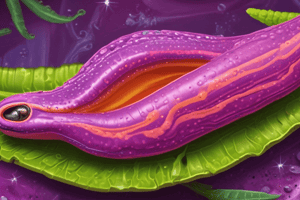Podcast
Questions and Answers
The phylum ______ includes flatworms.
The phylum ______ includes flatworms.
Platyhelminthes
The ______ class is a group of free-living flatworms.
The ______ class is a group of free-living flatworms.
Turbellaria
The image shows the general body plan of a ______.
The image shows the general body plan of a ______.
Turbellaria
The image of a ______ egg is shown.
The image of a ______ egg is shown.
This section of the content explores the ______ of Turbellaria.
This section of the content explores the ______ of Turbellaria.
Flashcards
Phylum Platyhelminthes
Phylum Platyhelminthes
A group of flatworms, including worms like tapeworms and flukes.
Class Turbellaria
Class Turbellaria
A class within Platyhelminthes known for free-living flatworms.
General body plan of Turbellaria
General body plan of Turbellaria
Typically characterized by a flat, soft body, often elongated.
Schistosoma mansoni
Schistosoma mansoni
Signup and view all the flashcards
Turbellaria locomotion
Turbellaria locomotion
Signup and view all the flashcards
Study Notes
Phylum Platyhelminthes
- Flatworms (~34,000 described + ~36,500 undescribed)
- One class free-living, three classes parasitic
- 80% of described species are parasitic
General Characteristics
- Acoelomate, triploblastic, and bilaterally symmetrical
- Free-living flatworms are the most primitive bilateral animals
- Free-living flatworms are the first group to evolve a true mesoderm
- Some species have anterior brains connected to ventral nerve cords
- Mesoderm develops into parenchyma tissues that lie between the outer body wall and gut endoderm
- No specialized circulatory system
Body Architecture
- Locomotion: Movement by beating ventral cilia; muscle contractions called pedal waves, which allow looping
- Sensory Structures: Eyespots, auricles, cerebral ganglia
- Excretory System: Protonephridia for osmoregulation (filtering waste)
Digestive System
- Food enters and unmetabolized wastes leave through the same opening
- Metabolized wastes are diffused through their flat body
- Protonephridia (first kidney) also eliminates other metabolic wastes, like ammonia, urea, and amino acids.
Reproduction
- All flatworms in the 4 classes are simultaneous hermaphrodites
- Eggs and sperm fertilize anytime when one flatworm encounters another.
- In general, most individuals cannot fertilize themselves
Class Turbellaria
- 16% of all flatworms
- Mostly aquatic (avoid dehydration), some freshwater and terrestrial
- Size ~1 cm long and ciliated
- Possess a primitive nervous system (including a cerebral ganglion)
- Unique structure called rhabdites that secrete mucus to avoid desiccation and predation
- Diverse digestive system types (no well-defined, to unbranched, three or multibranched gut)
Class Cestoda ("Tapeworms")
- Internal parasites (endoparasitic) primarily of vertebrates
- ~135 million people have tapeworm infections worldwide
- Small anterior, hooked attachment organ (scolex)
- Body divided into segments (proglottids) arising behind the scolex
- Absence of a digestive tract
- Proglottids function primarily for reproduction.
Class Monogenea
- Mostly ectoparasites of fishes
- Posterior attachment organ (haptor/opisthaptor) including suckers, complex attachment hooks, and sclerites.
- Larva (oncomiracidium) bearing 3 bands of cilia and usually 1 or 2 pairs of eyes.
- Very high species and sites specificity
- ~1100 species described; ~20,000 more believed to exist
- Life cycle does not involve intermediate hosts
Class Trematoda ("Flukes")
- Outer body layer is unciliated syncytial tegument
- Trematode bodies resemble turbellarians, but with mouth opening, blind-ended digestive tract, and no segments.
- Parasites ingest host tissues and blood through mouth
- Complex life cycle including 5 stages (miracidium, sporocyst, redia, cercariae, metacercariae)
- Often requiring 2+ intermediate hosts, typically mollusks
- Some species have sexual reproduction in the definitive host
Studying That Suits You
Use AI to generate personalized quizzes and flashcards to suit your learning preferences.




